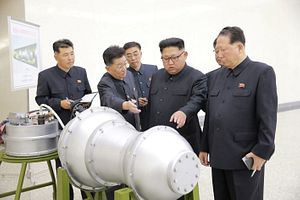Just months before North Korea flight-tested the Hwasong-14 intercontinental-range ballistic missile for the first time, I wondered in these pages how far away the United States was from seeing its old Cold War challenge of “decoupling” emerge in the context of its Northeast Asian allies.
Unfortunately, “decoupling” is not only back — it is arguably a major driving force behind North Korea’s recent provocative tests, including of a Hwasong-12 intermediate-range ballistic missile over Japanese territory in late-August and of a sixth nuclear device that appears to have a potential explosive yield in the hundreds-of-kilotons range.
North Korea has long bemoaned what it calls the United States’ “hostile policy” in Northeast Asia. This policy is premised primarily around the permanent U.S. forward-based military presence in Japan and South Korea, and Washington’s long-standing “ironclad” assurance to use all means necessary — conventional and nuclear — to come to the aid of its allies if they face a North Korean attack. North Korea also wraps up the United States’ strategic bomber patrols, sanctions, and even large military exercises in the region into the “hostile policy.”
If we grant Kim Jong-un the benefit of the doubt — as we should today — that he can indeed mount a 100+ kiloton nuclear warhead on the Hwasong-14 ICBM, it’s apparent why the decoupling problem is back. Before Kim Jong-un had demonstrated this important capability, Seoul and Tokyo could rest easy when the United States gave its assurances to back them up in a war.
In any war before the North Korean city-busting ICBM, there would be no way for Pyongyang to hold the U.S. homeland at risk. The United States could use nuclear weapons to terminate a war, decapitate the Kim regime, and possibly even forcefully reunify the Korean Peninsula under South Korean leadership.
Now, however, North Korea has taken the initiative and can look to terminate a war on its own terms, preserving its leadership and avoiding comprehensive U.S. nuclear retaliation. As Vipin Narang and I explained in War on the Rocks after North Korea’s first Hwasong-14 flight test, the ICBM capability allows North Korea to use coercive threats against South Korea and Japan — and possibly even initiate a war — with an insurance policy against comprehensive U.S. nuclear retaliation.
For that strategy to work and work well, the threat North Korea poses to the United States must be sufficient to deter Washington from coming to the aid of its allies. To do this, the threat must be credible. A 100+ kiloton nuclear test helps this credibility. A full-range ICBM flight test would additionally help North Korea’s credibility. The nightmare scenario — an atmospheric nuclear test off a full-range ICBM — would etch it in stone for Washington.
Additionally, as I argue in a recent piece for The Atlantic, this is why highly provocative North Korean activities, including the Hwasong-12 overflight of Japan and this most recent thermonuclear test, are rational for Kim Jong-un. They aren’t brazen and theatrical shows of might for no strategic payoff.
Anyway, these capabilities will lead to a serious consideration of the “decoupling” question again in some circles in Washington. For the moment, top U.S. officials, including Secretary of State Rex Tillerson and Secretary of Defense Jim Mattis, are working overtime to reassure allies of the health of extended deterrence commitments. U.S. President Donald J. Trump, too, in a recent phone call with Japanese Prime Minister Shinzo Abe has underlined that the United States remains ready to use conventional and nuclear weapons to defend Japan from attack.
But as North Korea’s capabilities grow more impressive and credible to the United States, those old Cold War-era questions, of why the United States would risk New York for London, Los Angeles for Bonn, and Chicago for Paris, will come to bear.
North Korea is betting that eventually, the American public or even inwardly oriented leaders like Trump may decide that no, the United States should not risk New York for Seoul or Tokyo. Subsequently, North Korea is hoping for a withdrawal of U.S. forces from Northeast Asia and an end to the “hostile policy,” whose cornerstone is extended deterrence.
If there is a “win scenario” for North Korea short of reunification of the Korean Peninsula under its leadership, that’s it for now. The ICBM tests and the new thermonuclear test fit into that schema like a hand into a glove.

































